Learning to kitesurf in Hawaii is exciting and easier than you might think. The islands offer warm waters, steady winds, and many beginner-friendly schools, so you can start riding the waves with just a few lessons.
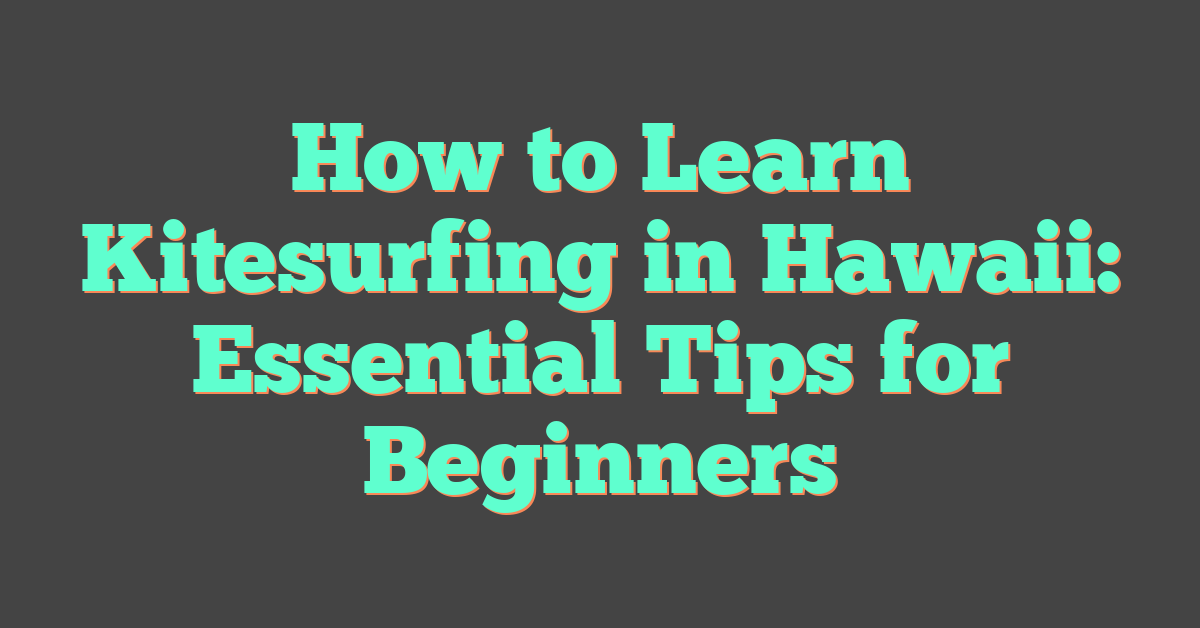
Professional instructors will guide you, and you get modern gear included. This helps you feel safe as you learn the basics.
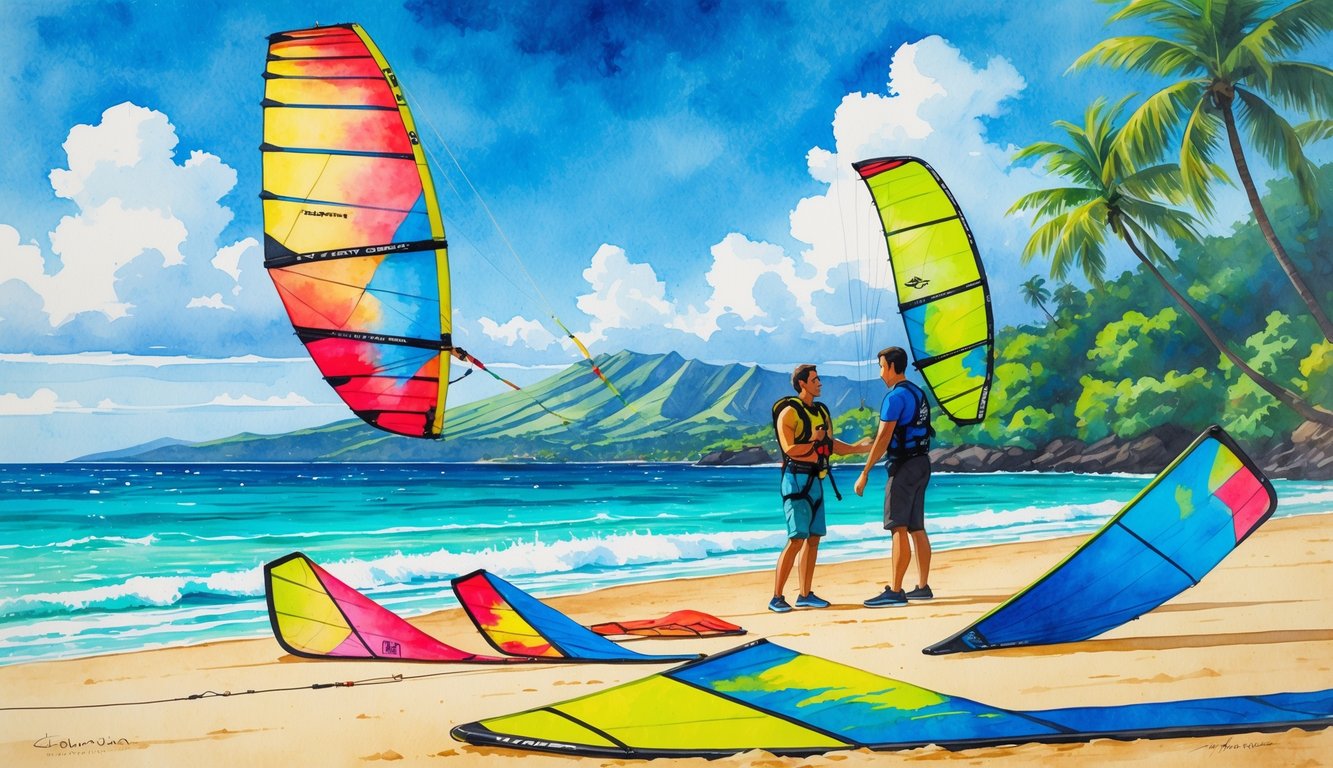
Hawaii’s stunning beaches and steady trade winds make it a great place to try kitesurfing. Places like Maui and Oahu have smooth sandy shores and calm spots, so you can practice safely at any skill level.
With a little time and patience, you’ll soon glide across the water. Expert help and good locations make learning this sport simple.
Why Learn Kitesurfing in Hawaii?
I chose Hawaii for its great wind, beautiful water, and welcoming atmosphere. Here, I find not just good weather, but a true kitesurfing paradise and a supportive local scene.
Unique Conditions and Scenery
Hawaii’s islands give steady trade winds that are perfect for kitesurfing almost all year. From May to September, the breeze stays reliable, letting you spend more days on the water.
The water is warm, so you don’t need a wetsuit. Kite Beach near Kahului airport offers safe learning spots and easy launch zones.
Maui’s north shore, including Hookipa Beach Park, attracts top kitesurfers and windsurfers from around the world. Paia, Lahaina, and Kihei are great for beginners with gentle waves and sandy beaches.
On the water, you see emerald mountains, rainbow skies, and clear blue waves. The scenery adds to the experience.
If you want a challenge, you can ride over reefs or try bigger surf farther out. There’s a spot for every skill level, so you can try new tricks as you improve.
Vibrant Local Kitesurfing Community
When I started learning here, I saw how friendly and helpful the local kitesurfers are. People share advice, lend gear, and help each other launch.
Maui hosts events like the PWA Hawaii Pro, so you can watch professionals and pick up new skills. The local scene mixes visitors, locals, and pros, making everyone feel welcome.
Certified instructors offer lessons across the islands, and shops rent or sell all the equipment you need. Social events, group rides, and competitions keep things lively.
Hookipa Beach Park and other beaches in Maui are great places to join this active community.
Choosing the Best Time to Kitesurf
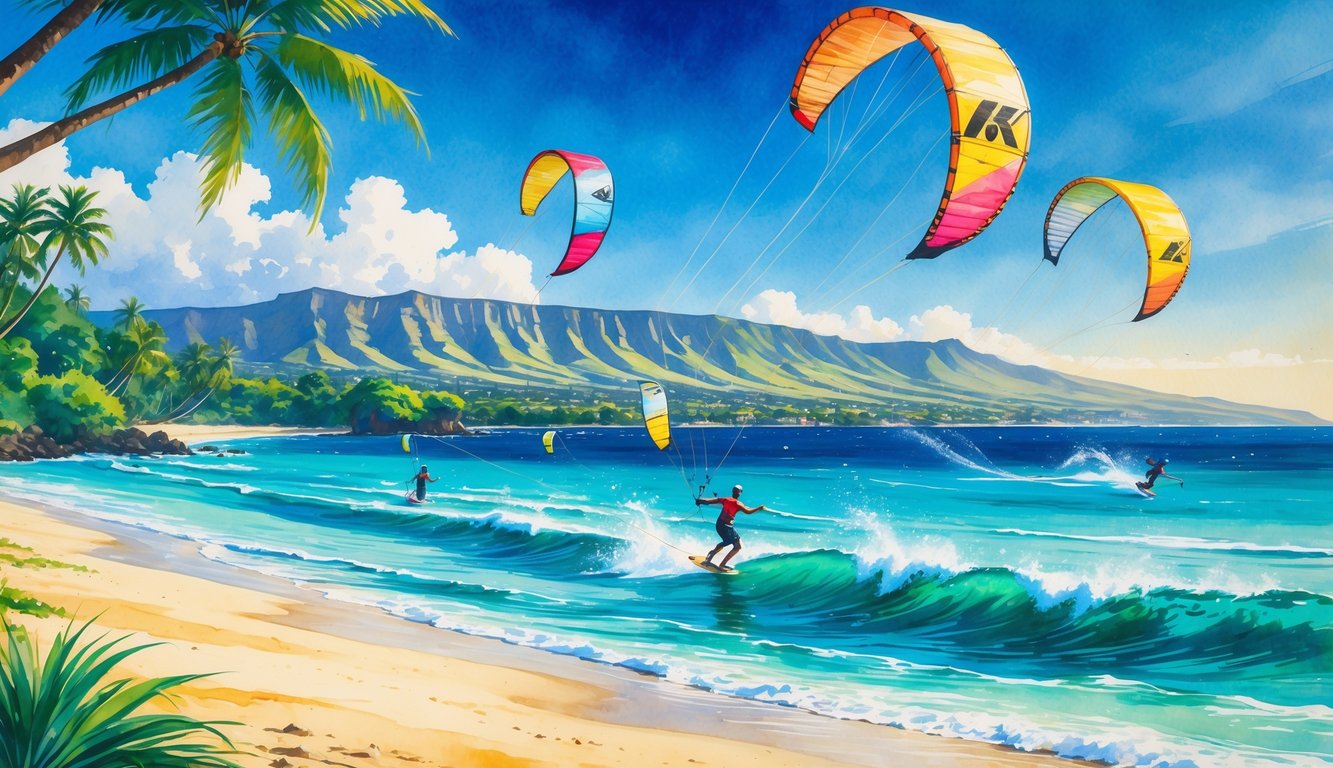
Choosing the right time to go kitesurfing in Hawaii can make your experience much better. Different months bring different conditions, and some spots fit certain skill levels.
Weather and Wind Patterns
Wind matters most for kitesurfing. In Hawaii, the trade winds are strong and steady from May to September.
These months give the most reliable wind, usually between 15 and 25 knots. This makes kitesurfing fun and safe, especially for beginners.
Summer is drier, so you spend more time on the water and less hiding from rain. The weather can change fast, so always check the forecast before heading out.
During these months, you see fewer storms, so the water stays smoother and the wind steadier. Tides also matter.
Going out as the tide rises or falls gives you cleaner water and easier waves. Avoid midday sun because it gets too hot and the wind can get rough.
Seasonal Pros and Cons
From May to September, you get the best wind for kitesurfing in Hawaii. The water is warmer, and days are longer, so you can practice more.
Popular beaches get busy in summer, especially Maui’s north shore and Oahu’s Mokuleia Beach Park. For a quieter session, go early in the morning or late in the afternoon.
In winter, fewer people go kitesurfing, but the wind is less predictable. Trade winds slow down, and some days stay calm.
If you go out in winter, watch for rain and bigger waves, which can be harder for beginners. For more about season timing, visit Kitesurfing in Hawaii: Best Spots & Vacation and Kitesurfing in Hawaii – kitetrip-planner.com.
Top Kitesurfing Locations in Hawaii
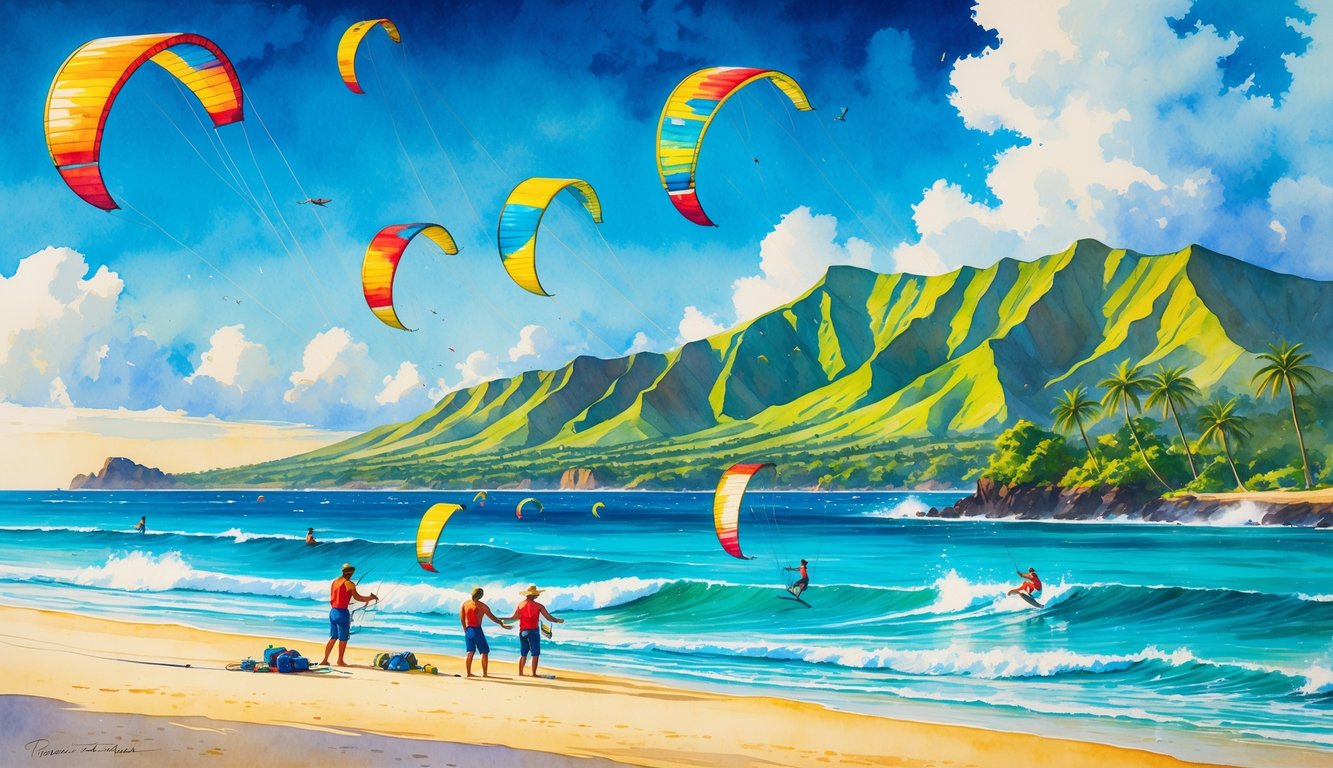
Hawaii has some of the best places for kitesurfing, kiteboarding, and wing foiling. Each island gives you a unique mix of wind, waves, and scenery.
You can find lessons or meet other riders at the main beaches.
Maui’s Kitesurfing Beaches
For steady winds and beautiful views, head to Maui. The north shore is famous for world-class kitesurfing.
Kanaha Beach Park is the most popular spot. The wind is consistent, especially from May to September, making it great for learning.
Shallow water near shore helps beginners, and the outside reef gives fun waves for advanced riders. Windsurfing and wing foiling are common here, so there’s always something happening.
Maui has many professional schools and gear rental shops nearby.
Hookipa Beach Park is a spot where top windsurfers and kiteboarders show off tricks. It’s best for experienced riders because of bigger waves and strong currents, but it’s inspiring to watch.
Find more about kitesurfing in Maui at travelwiththegreens.com.
Oahu’s Popular Spots
On Oahu, Kailua Beach is a favorite for kitesurfing and kiteboarding. It has soft sand, turquoise waters, and steady trade winds.
The water is calm and flat, which helps beginners practice safely. Many schools and shops are nearby, so it’s easy to try wing foiling or get lessons.
Kalama Beach and Lanikai Beach also work well for beginners because of gentle waves. Mokuleia Beach on the North Shore has stronger winds and bigger swells, which suit more experienced riders.
Oahu makes it easy to meet the local kitesurfing community and improve your skills. For more about lessons and schools around Honolulu, see Yelp’s Honolulu Kite Surfing Lessons.
Hidden Gems on Other Islands
The Big Island and Kauai have less crowded kitesurfing spots for a more relaxed session. On Kauai, Anini Beach is a favorite because its protective reef keeps the water calm.
The Big Island has beaches like Kiholo Bay and Ka’upulehu. These beaches are quieter, so you get more space.
Winds can be less predictable here, but on a good day, the experience feels special. Some spots are shared with surfers and wing foilers, so you see a mix of water sports.
For more about these hidden gems and the best time to go, check Kite Jungle’s guide on Hawaii and Boardsvibes Hawaii kitesurfing guide.
Essential Equipment for Beginners
When I started kitesurfing in Hawaii, the right equipment made learning easier and safer. Picking good gear affects how comfortable, safe, and confident you feel on the water.
Kites and Boards
A trainer kite helps you learn basic kite control on land. When you’re ready for the water, use an inflatable leading edge kite, which is common for kitesurfing and kiteboarding.
Choose a kite size that matches your weight and the wind. Use a smaller kite in strong winds and a larger kite in light winds.
Most beginners start with kites between 9-12 meters. For boards, a larger twin-tip board works well.
Bigger boards float better and make it easier to stand up and ride. If you try wing foiling, look for a wider, more stable board.
Here’s a quick look at options:
| Equipment | Good for Beginners? | Why |
|---|---|---|
| Trainer Kite | Yes | Easy to handle, safe |
| Inflatable Kite | Yes | Stable and versatile |
| Twin-tip Board | Yes | Controls easily |
| Foil Board | Maybe | More advanced, for wing foiling |
Safety Gear
Wearing safety gear keeps you confident and protected. Always wear a helmet and an impact vest.
A helmet protects your head, and an impact vest gives you buoyancy and shields your ribs. Use a harness to stay attached to the kite.
Beginners often prefer a seat harness because it sits lower and feels more stable. Rely on a quick-release safety system to detach from the kite fast if you lose control.
For wing foiling, use a board leash to keep your board close if you fall.
Basic safety gear includes:
- Helmet
- Impact vest or flotation jacket
- Harness (seat or waist)
- Quick-release system
- Board leash (especially for foiling)
What to Bring to the Beach
When I plan a kitesurfing session, packing the right things makes my day smoother.
I always bring extra water and snacks to stay hydrated and energized.
Sun protection is important, so I use waterproof sunscreen, sunglasses with a strap, and a hat when I’m not in the water.
A wetsuit or rash guard keeps me safe from sunburn and jellyfish.
In warmer months, a shorty wetsuit or just a rash guard works for most people in Hawaii.
I also pack a towel, change of clothes, and a waterproof bag for valuables.
I check my gear bag for:
- My kite and board
- Safety equipment
- Repair kit for small fixes
- First aid kit
- Beach shoes for rocks or coral
For more details on the basics, I use this overview for new riders.
Enrolling in Kitesurfing Lessons
I signed up for lessons because the right guidance makes kitesurfing, kiteboarding, and surfing safer and easier to learn.
A pro instructor helps me avoid mistakes and builds my skills step by step.
Finding Certified Instructors
I look for instructors who are certified, experienced, and familiar with local conditions.
Certified schools show credentials from groups like the International Kiteboarding Organization (IKO) or Professional Air Sports Association (PASA).
These certifications show instructors know how to teach safety and handle emergencies.
I check reviews and ask about their safety record and teaching style.
Many schools, like Maui kitesurfing schools or Kiteboarding Paradise Hawaii, list their experience and offerings online.
Some schools provide an instructor in the water or an escort boat, which helps lower stress.
I always look for:
- Instructor certifications
- Quality equipment
- Good student-to-instructor ratios
- Positive student feedback
What to Expect in Your First Lesson
During my first lesson, the instructor showed me how to safely set up and check all the kitesurfing equipment.
We started on the beach and learned to control the kite, practicing launching, landing, and steering.
At first, we focused on safety and understanding wind and weather.
Once I learned the basics, we covered how to use the harness and what to do in common situations.
I learned waterstarting, which is how to get up on the board.
Beginners’ lessons, like those at Hawaiian WaterSports and Honolulu Kite School, include hands-on time and clear instructions.
Some schools offer lessons with a jet ski or escort boat to help beginners feel more secure in the water.
Most classes last about 2 to 3 hours, giving enough time to practice but not so long that I get tired.
Developing Your Kitesurfing Skills
Getting better at kitesurfing in Hawaii takes steady practice.
I learn new techniques and work through common challenges.
The right approach helps me improve faster and avoid mistakes.
Progressing from Beginner to Intermediate
When I first learned kitesurfing, I focused on staying safe, controlling the kite, and getting up on the board.
As I improved, I started riding both directions, practicing water starts, and riding upwind.
My instructor gave me direct feedback, like how to adjust my body position and steer the kite better.
This made each lesson more effective.
I met other riders through local group lessons, which helped me learn new tips and feel more confident.
I kept track of what I learned after each session.
Here’s a simple chart I used:
| Skill | Beginner | Intermediate |
|---|---|---|
| Kite Control | ✔ | ✔✔ |
| Water Start | ✔ | ✔✔ |
| Upwind Riding | ✔ | |
| Transition Turns | ✔ |
Joining the kitesurfing community in Hawaii helped me get better, as riders often share advice about local wind patterns and safe spots.
For a helpful overview, I checked this complete guide to kite surfing in Hawaii.
Common Mistakes to Avoid
At first, I made a few mistakes that could have been dangerous or slowed my learning.
I tried to launch the kite without checking the wind direction, which almost led to accidents.
Now, I always make sure I’m upwind and the area is clear before I set up.
I also held the bar too tightly, which made the kite hard to control.
By relaxing my grip and listening to my instructor, steering the kite became much smoother.
Sometimes, I tried to ride in strong or gusty winds before I was ready.
It’s best for beginners to stick to steady, moderate winds.
Instructors at local schools, like the ones in Maui, always point this out.
Here are three mistakes I watch out for:
- Not checking equipment before each session
- Forgetting to use a safety leash
- Skipping warm-up exercises
Knowing these problems lets me fix them quickly and stay safe while practicing kiteboarding in Hawaii.
Safety Tips for Kitesurfers
Before I go kitesurfing in Hawaii, I pay close attention to local laws and ocean conditions.
Staying safe isn’t just about skill—it’s about being smart and prepared.
Understanding Local Regulations
When I kitesurf in Hawaii, I check the beach rules and look for posted signs.
Some spots only allow kitesurfing in certain areas or at certain times.
Parks may close during turtle nesting season or limit how close I can ride to swimmers and surfers.
Knowing these rules protects wildlife and keeps everyone safe.
I take a lesson or talk with local instructors before my first session at a new spot.
Instructors teach me about the local “do’s and don’ts,” which are not always posted online.
I also register my kite and follow any rules about launching and landing.
Some places require me to wear a helmet or life jacket and carry a line knife in case of emergency.
If I am far from shore, I bring a waterproof phone or safety device.
The Hawaii coastline can be unpredictable, so being able to call for help is important.
For more on this, I follow Hawaii’s kitesurfing regulations and safety protocols.
Respecting Ocean Conditions
Hawaii’s waves and winds change quickly, so I check the forecast before kiting.
Wind speed and direction matter.
Strong winds need a smaller kite, while light winds need a larger one.
As a beginner, I use a 10 to 12 meter kite, which works for most days.
I watch the water for rip currents, strong tides, or sudden weather changes.
If I see darker water or choppy spots, I avoid them.
Staying away from coral reefs and rocks keeps me safe and protects the reefs.
I never go out alone, and I make sure someone knows where I am.
When waves get too big, I stay on shore until conditions improve.
Local advice is valuable—I learn a lot just by talking to surfers and other kitesurfers on the beach.
For more practical tips, I check expert kitesurfing safety advice for Hawaii.
Exploring Related Water Sports in Hawaii

Hawaii is a playground for water sports lovers like me.
With steady trade winds and warm water, it’s easy to try activities beyond kitesurfing.
Wing Foiling Adventures
Wing foiling has quickly become one of my favorite water sports.
This sport uses a handheld inflatable wing and a board with a hydrofoil.
The foil lets me glide above the water, even with light winds.
It feels smooth and almost silent, and it’s easier on my body than traditional kiteboarding.
Wing foiling is accessible.
I don’t need strong wind, and the setup is quick.
Many local schools on Oahu and Maui offer lessons and rentals.
Some shops run special beginner classes, so I can learn the basics before going out alone.
Safety tip: Always check wind and wave conditions before heading out, and wear a leash and vest for extra protection.
Hawaii’s beaches, with flat water spots and gentle winds, are ideal for learning.
Blending Kitesurfing with Surfing
Combining kitesurfing and surfing makes my time in Hawaii more fun.
Kitesurfing lets me ride upwind and catch waves I couldn’t reach by paddling.
After a kitesurfing session, I like to switch to a surfboard and catch sets with just the power of the waves.
Some spots, like Waikiki and Hookipa Beach Park, are popular for both sports.
The mix of kitesurfers and surfers creates a unique vibe.
I respect right-of-way rules and always give beginners extra space.
When the wind drops, I switch from kiteboarding to regular surfing without leaving the water.
Trying both styles helps me become a better rider.
Shops rent surfboards and kitesurfing equipment, which makes it easy to enjoy both sports in one trip.
If I want a full day of adventure, I bring both boards and use whichever suits the conditions.
For more info, I check guides like this about kitesurfing in Hawaii.
After Your Kitesurfing Session

Once I leave the water, I do a few things to improve my experience and keep my gear in good shape.
Being in Hawaii means I also get to enjoy the local beach atmosphere and meet new friends.
Beach Culture and Community
Kitesurfing in Hawaii means more than just riding the waves. The beaches buzz with friendly people who share stories, tips, and encouragement.
After my session, I chat with other kitesurfers or watch the local pros land cool tricks. People often hang out on the sand, have snacks, or listen to music together.
I always feel welcomed, even if I’m new to the area. I respect local customs by picking up trash, giving space to others, and sharing the shoreline.
Sometimes, I see events or group lessons happening, which makes it easy to ask questions and learn from experienced riders.
Caring for Your Equipment
After kitesurfing, I rinse my kite, bar, and lines with fresh water to remove salt, sand, and dirt. This quick step helps prevent rust and damage.
I check my kite for small tears or signs of wear, especially along the seams and valves. Sand gets everywhere, so I empty pockets or bags and make sure zippers stay clear.
Next, I let my kite and gear dry in the shade to keep colors from fading in the strong Hawaiian sun. Once dry, I roll my kite loosely to avoid creases and pack everything neatly.
Local businesses like Kiteboarding Paradise Hawaii share care instructions and usually handle most cleaning for rentals or lessons.
Sustainable Kitesurfing Practices
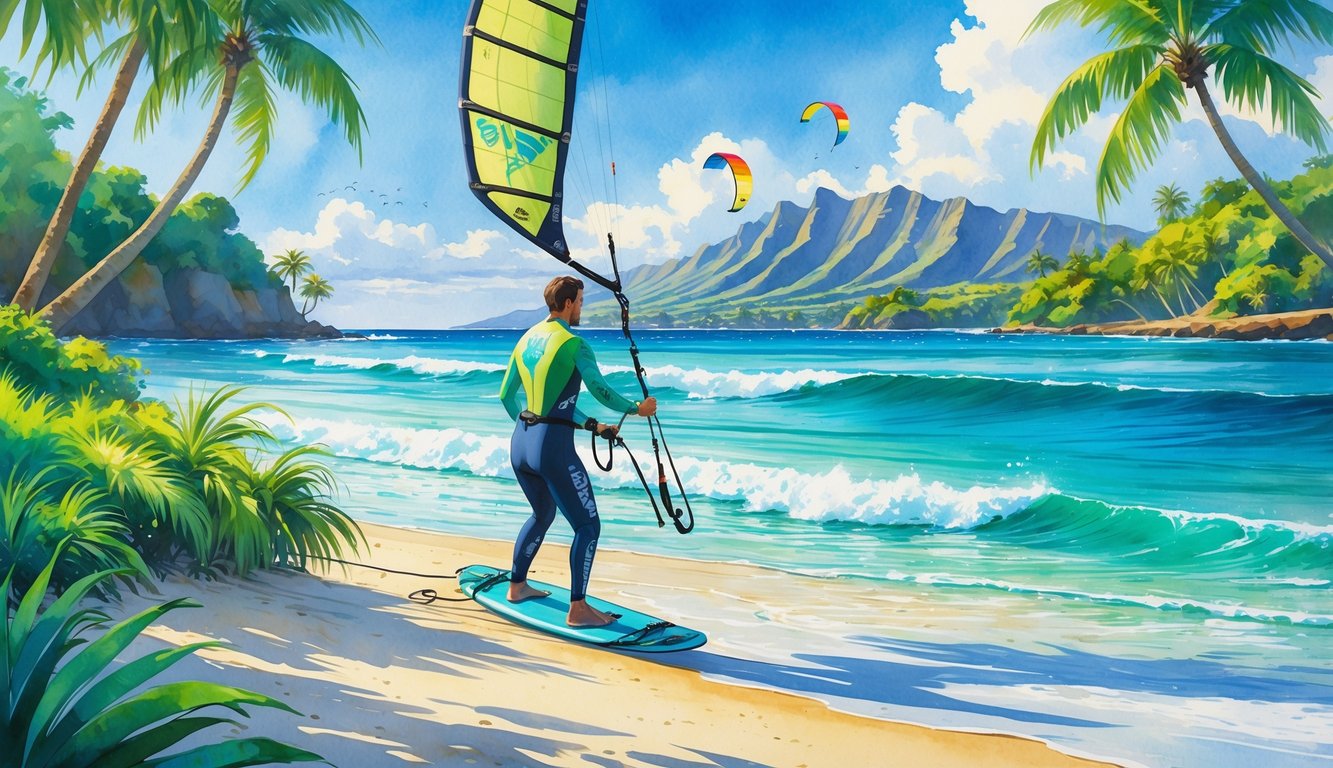
When I kitesurf in Hawaii, I make choices to protect the ocean and land. I work to keep the beaches clean and support the local people and wildlife.
Respecting the Hawaiian Environment
I always clean up after myself and make sure I leave no trash or gear on the sand. I stay away from fragile reefs and avoid disturbing animals like sea turtles or monk seals.
I use eco-friendly sunscreen that won’t harm the coral. When I choose gear, I look for brands that use recycled or low-impact materials.
Sharing rides to the beach helps cut down on pollution and traffic. I follow local rules, such as launching and landing my kite only in allowed zones and keeping my distance from swimming areas.
Learning about native plants and wildlife helps me avoid harming them. These simple steps help me protect the place I love to surf.
Supporting Local Initiatives
I support businesses and organizations that care about Hawaii. I buy my equipment and take lessons from local shops.
This choice helps local people and boosts the economy. It also makes the community stronger.
I join beach clean-ups or events that local groups organize whenever I can. These activities let me give back and meet others who want to protect the coastline.
Many Hawaiian kitesurfing schools teach about sustainable practices. I follow these lessons closely.
I choose tours or classes that focus on being eco-friendly. This way, my surfing experience is good for both me and the island.
For more tips, guides like Kite Surfing in Hawaii: A Complete Guide share ways to kitesurf responsibly.




